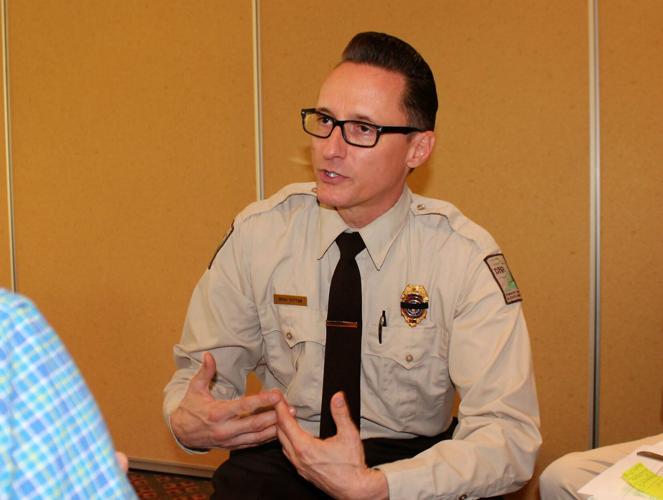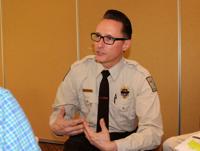The hot, dry temperatures have not been a friend to firefighters or scenic Utah. One spark could explode into a wildfire within seconds. Last year, a total of 219,840 acres of Utah burned by wildfire. This year, to date, there have been 239,716 acres in Utah burned by wildfire, said Christina Boel, Communications and Education National Park Service Division of Fire and Aviation Management.

Brian Cottam, the State Forester met with the Kiwanis Club of Logan Wednesday to talk about 2018 wildfire season.
This year’s fires are still far from the biggest wildfire in state history, that honor goes to the Millard Flat Fire which blackened 363,052 acres near Milford, Utah, caused by a lightning strike in July 2007.
State Senator Lyle Hillyard invited Brian Cottam, the Utah State Forester, to meet with the Kiwanis Club of Logan Wednesday.
He reported some stark numbers about this year’s wildfire season. And although it may not be the biggest fire season, in terms of acreage, it is one of the most expensive.
Cottam said wildfires last year cost $50 million, this year’s cost has doubled to $100. The wildfire season won’t end until October or when snow comes.
“In a normal fire season we may have zero to 37 structures burn,” Cottam said. “This year we had 370 structures burn.”
A structure can be anything from a chicken coop to a barn. Of those 370 structures, 87 homes were destroyed he said.

In this this photo taken Monday, July 2, 2018, and provided by Darren Lewis, a wildfire burns near Strawberry Reservoir, Utah. The fire is threatening a cabin that Lewis and his extended family planned to spend the Fourth of July at in the Utah wilderness built nearly 50 years ago by his father and uncle. Instead, Lewis and his family will spend the holiday nervously waiting to hear if a half century of family memories go up in smoke. (Darren Lewis via AP)
He told the Kiwanis Club that although it is expensive fighting the fires the real expense comes from rehabilitating the scarred acres.
“People are tired,” Cottam said.
“Firefighters have been out there every day since May 7,” said Brandon Jensen, a fire officer. “They are expected to go until into October.”
He said firefighters work 12 to 16 hour days and get two days off every 14 days. That changes if they have to drive a long distance to a new fire, he said.
After three years of negotiating, Cottam engineered a partnership with the Utah Legislature, Utah League of Cities & Towns, Utah Association of Counties, and Utah Fire Chiefs’ Association. They have completely rewritten the wildfire statutes and instituted a new fire management system in Utah.

Brian Cottam, the State Forester met with the Kiwanis Club of Logan Wednesday and took questions about the 2018 wildfire season.
“The policy clarifies the state’s relationship with county and city government with regards to fire management and how suppression is paid for (and who pays it); it also codifies local government’s responsibility for reducing the risk of wildfires,” he said.
Cottam said it’s about implementing measurable prevention, preparedness, and mitigation actions in order to participate in the new system.
He said successfully implementing this progressive policy is one of our priorities here in Utah.







(0) comments
Welcome to the discussion.
Log In
Keep it Clean. Please avoid obscene, vulgar, lewd, racist or sexually-oriented language.
PLEASE TURN OFF YOUR CAPS LOCK.
Don't Threaten. Threats of harming another person will not be tolerated.
Be Truthful. Don't knowingly lie about anyone or anything.
Be Nice. No racism, sexism or any sort of -ism that is degrading to another person.
Be Proactive. Use the 'Report' link on each comment to let us know of abusive posts.
Share with Us. We'd love to hear eyewitness accounts, the history behind an article.